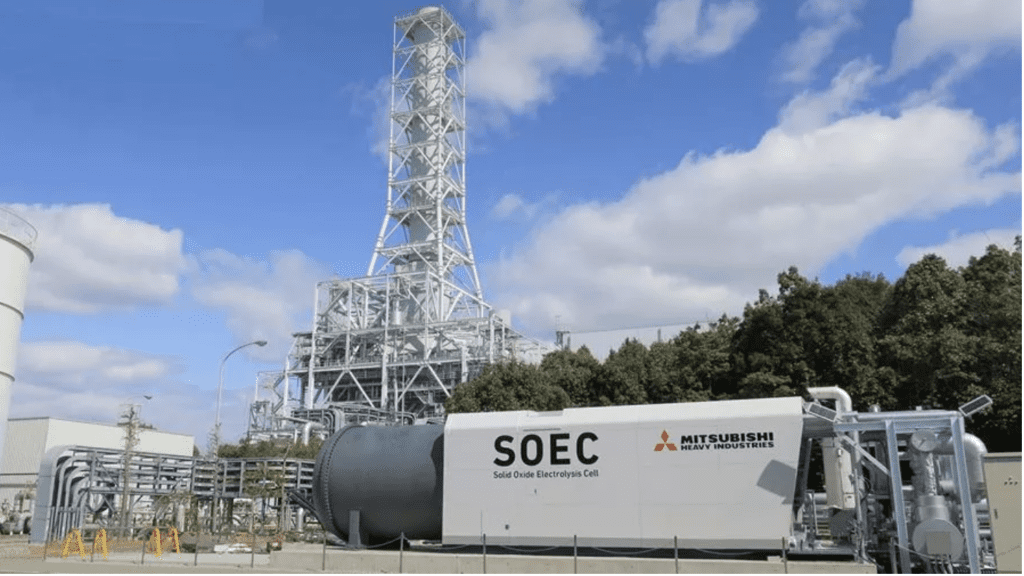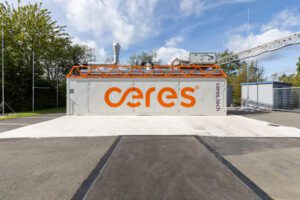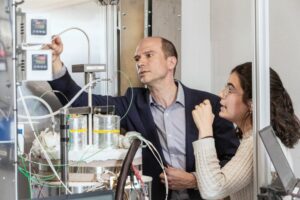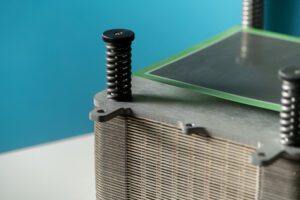Solid-oxide electrolyzer cell (SOEC) and solid-oxide fuel-cell (SOFC) technologies are poised to change the face of power generation and hydrogen production. SOEC offers intrinsically higher efficiencies than other electrolysis technologies, such as alkaline, polymer electrolyte membrane (PEM) or anion-exchange membrane (AEM) electrolyzers. Notably, when SOEC technology is coupled to external heat sources from industrial processes, efficiencies in the range of 90% and beyond can be achieved. This makes SOEC technology a promising choice in industrial hydrogen production and also in e-Fuels production, especially where the exhaust heat of the synthesis process can be used. This article discusses some recent industrial developments related to the adoption and evolution of SOEC and SOFC technologies.
Technology scaleup and demonstration
One of the most significant indicators of SOEC expansion was the April 2024 announcement that Topsoe A/S (Lyngby, Denmark) was planning to construct a factory in Virginia to manufacture SOECs for the hydrogen sector. This new plant has a planned capacity of more than 1 GW. And Topsoe’s plans go beyond this plant — Topsoe also established an alliance with ABB (Zurich, Switzerland) and Fluor Corp. (Irving, Tex.) to create a standardized framework for the construction of future SOEC manufacturing plants.
Topsoe’s SOEC technology in particular was the subject of a study led by nuclear energy firm ULC-Energy B.V. to demonstrate the economics of hydrogen production using SOEC technology combined with a Rolls-Royce small nuclear reactor (SMR). The study revealed significant advantages of the SMR-SOEC combination, including:
- The Rolls-Royce SMR power plant can operate 24/7, with 95% availability
- SOEC electrolysis can produce more hydrogen per total power input when compared to conventional electrolyzer technologies
- Steam can be supplied directly from the nuclear power plant heat exchangers
- Hydrogen production can take place ‘off-grid’
The results revealed that hydrogen can be produced by the SMR–SOEC combination for less than €3.50/kg, which is significantly better than alternatives that lack the continuity and flexibility of nuclear energy. This cost can be driven down to less than €2.00/kg by 2050 by taking into account the value of the flexibility to curtail hydrogen production and deliver electricity to an increasingly intermittent grid.
Sundus Cordelia Ramli, Topsoe’s chief commercial office, Power-to-X, added: “Topsoe’s SOEC technology has been under development for over 15 years. Last year, ground was broken at the 500 MW SOEC manufacturing facility and SOEC will be commercially deployed as production is ramped up. The high capacity factor of nuclear power plant, together with a direct source of heat, makes combinations using nuclear power plants and SOEC extremely interesting and we look forward to continuing our work with ULC-Energy and Rolls-Royce SMR.”
Last September, Mitsubishi Heavy Industries, Ltd. (MHI) started up the Takasago Hydrogen Park in Japan, a first-of-its-kind validation center where the company will test several different electrolysis technologies. A few months later, in April 2024, the company started operation of a 400-kW SOEC test module at the site. This module utilizes MHI’s proprietary tubular-cell stack supports, which makes the SOECs capable of operating at high pressures, setting them apart from competing systems, says MHI. The SOEC test module comprises a module with multiple cartridges of 500 cell stacks bundled together. During test operations, the electrolytic efficiency of the module was 3.5 kWh/Nm3 (101% higher heating value [HHV]), confirming that the module was operating with notably high efficiency. MHI sees this as a major step forward toward achieving a system with an overall efficiency of 90%-HHV.

400-kW class SOEC test module at Mitsubishi’s Takasago Hydrogen Park (Source: MHI)
Other significant SOEC developments in the works include:
- A pilot plant from thyssenkrupp nucera and the Fraunhofer Institute for Ceramic Technologies and Systems IKTS, slated to start up in 2025
- TS Elino GmbH and Salzgitter AG collaboration to convert an existing steel mill to climate-neutral production methods using waste heat to increase the electrical efficiency of SOEC technology
- Phillips 66 and Georgia Tech awarded funding to demonstrate the commercial feasibility of a reversible SOFC system for hydrogen and electricity generation
Solid-oxide technology for data centers
Bloom Energy Corp. (San Jose, Calif.) announced on July 22 a strategic partnership with CoreWeave, Inc. under which Bloom will deploy its proprietary SOFC technology to generate on-site power for CoreWeave at a high-performance data center owned by Chirisa Technology Parks located in Volo, Ill. This modern data center will allow for high-density deployments with advanced cooling systems, allowing CoreWeave to offer performant and efficient cloud solutions for artificial intelligence (AI) technologies. Bloom’s fuel cells are set to be commissioned in the third quarter of 2025.
“Bloom Energy is thrilled to have been selected by CoreWeave,” said Aman Joshi, Bloom Energy’s chief commercial officer. “This validation from CoreWeave, a leader in AI, is a testament to our leading-edge technology and its importance to AI.”
“We’re proud to partner with Bloom Energy and utilize their industry-leading solid oxide fuel cell technology,” said Brian Venturo, CoreWeave’s chief strategy officer. “This partnership will allow us to deliver unmatched performance and reliability to our customers while advancing our sustainability objectives.”
In the past few months, Bloom has also announced partnerships with Shell and SK ecoPlant to industrially deploy and accelerate its solid-oxide technologies.
Partnerships and expansion in Asia
Ceres Power Holdings plc (Horsham, U.K.) recently signed a global long-term license agreement for the manufacture of its proprietary SOEC technology with a global original equipment manufacturer (OEM) headquartered in the Asia Pacific region. This agreement provides revenues for license fees, engineering services and hardware over multiple years, similar to the profile of previous OEM licenses. The agreement also provides for royalty payments to Ceres on future commercial production and sale of SOEC equipment to end customers.
The company is also under contract with Shell to design an SOEC module for use in large-scale industrial applications such as synthetic fuels, ammonia and green steel, representing the the second phase of the companies’ collaboration. Ceres has been working with Shell since 2022, leading to the deployment of a 1-MW SOEC system at Shell’s R&D facility in Bangalore, India. Building on this demonstration, the focus of this contract is to develop a pressurized module design that can be scaled to hundreds of megawatts and be integrated with industrial plants to produce sustainable future fuels.

Ceres’ first of its kind solid-oxide electrolyzer (Source: Ceres Energy Holding; www.ceres.tech)
Commenting on the new licensing partnership, Phil Caldwell, chief executive officer of Ceres, said: “We are making great commercial progress this year, and I am particularly excited by the advances in our highly efficient and differentiated SOEC electrolyzer technology, which is now being adopted by several leading global companies with the manufacturing, supply chain and balance sheet strength to bring this technology to market at scale.
This builds on Ceres’ strategy to establish partnerships in regions with strong manufacturing capability coupled with ambitious targets for the use of hydrogen for industrial decarbonization. Last year, the company announced a partnership with Linde Engineering (Pullach, Germany) and Robert Bosch GmbH (Gerlingen, Germany) to validate the performance, cost and operational functionality of its SOEC technology. Ceres is also partnering with HyAxiom, Inc. (HyAxiom) and Doosan Fuel Cell Ltd. (DFCC) in developing and manufacturing solid-oxide fuel cell technology.
Funding for Power-to-X
Dynelectro ApS (Sjælland, Denmark) recently announced an €11-million investment round, which will enable the company to build its 1-MW Dynamic Electrolyzer Unit (DEU) technology, facilitating broader deployment into the green hydrogen market. Complemented by €9 million in grants from the European Innovation Council (EIC) and the Danish Energy Technology Development and Demonstration Program (EUDP), plus other regional programs, Dynelectro will utilize the funds for the development of DEUs from 150-kW prototypes to the commercial-scale fully modular 1-MW units.
Dynelectro’s technology focuses on next-generation solid-oxide electrolysis and offers robust system performance and longevity. SOE aids decarbonization in hard-to-abate sectors by efficiently producing hydrogen and utilizing industrial waste heat, says Dynelectro.

Dynelectro raised €11 million to develop and deploy their electrolyzer at European Energy’s Danish renewable energy facility (Source: Dynelectro)
“Dynelectro is an exemplary example of a company that has developed sustainable solutions with venture capital that we need both in Denmark and worldwide. We are pleased that a Danish company has cracked the code to make electrolysis more profitable, and how Dynelectro strengthens Europe’s position as a pioneer in Power-to-X,” says Christian Winther, Partner, Tech & Industry, EIFO Investment.
“We are excited to reach this pivotal stage in our growth,” said Sune Lilbaek, chief executive officer of Dynelectro. “This investment round not only validates our technology, but also sets the stage for our growth and significant advancements in sustainable energy in general.” Dynelectro added Yara as an investor in March 2024, which further demonstrates market interest for the technology. Yara International ASA (Oslo, Norway) operates the largest global ammonia network and just opened a new green-hydrogen plant in Norway in June.
Current electrolysis technologies waste 25-50% of input electricity, limiting their commercial and sustainability potential, according to Dynelectro. Solid oxide electrolysis (SOE) offers the highest conversion efficiency, but has historically been hindered by short lifespan, making it cost-prohibitive. Dynelectro’s innovative AC:DC technology addresses this issue, extending SOE lifespan from 2 years to 10 years, thereby aligning it with other electrolyzer technologies. This advancement reduces costs and enables quick production adjustments, aiding in grid-balancing through ancillary services. Consequently, Dynelectro becomes a crucial partner for Power-to-X developers striving to lower green hydrogen costs.
The completion of the first 1-MW unit installation at European Energy’s renewable energy facility in Denmark is scheduled for the first half of 2025, demonstrating the practical applications and benefits of this advanced energy solution.
Eva Nielsen, Global PTX Advisor, Ramboll Group, says: “Dynelectro has made inventions and holds rights to several significant patents that have the potential to lead to a significant breakthrough for hydrogen technology and Power-to-X.”
According to the EIC technical evaluation, “[the technology] may significantly transform and strongly accelerate a major new market. It therefore justifies a breakthrough characterization. It supports the adoption of hydrogen as a major clean energy carrier and strongly contributes to the EU’s Green Deal.” The European Investment Bank’s involvement in this round marks a step change in our maturity, transitioning our investor profile toward industrial investors.
